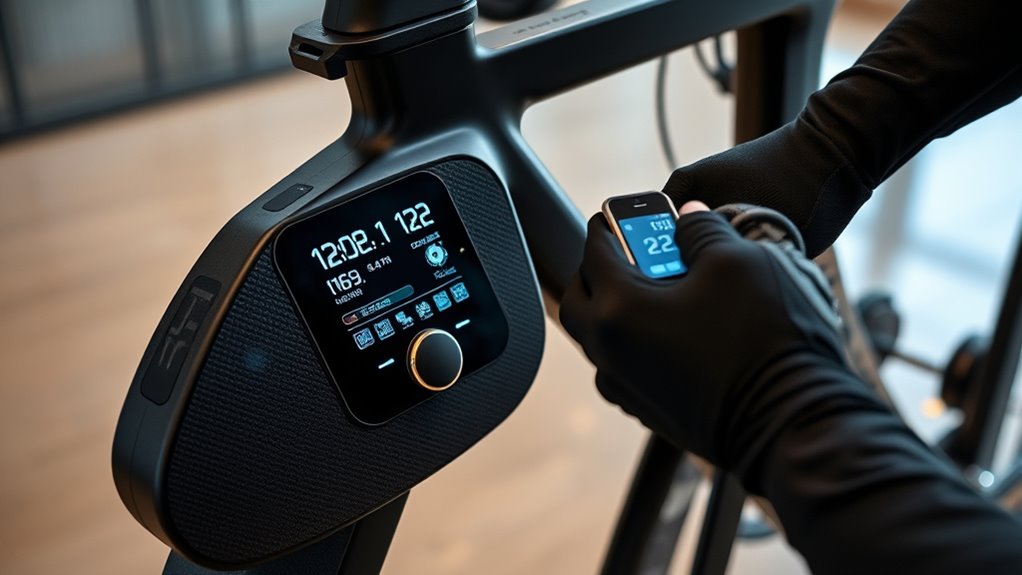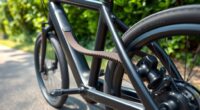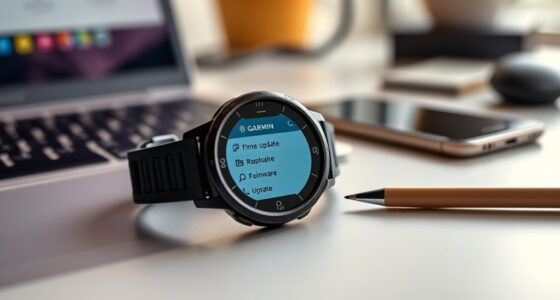Integrating power meters with smart trainers helps you get more precise and consistent data for your workouts by combining external power readings with automatic resistance adjustments. You should connect the devices via Bluetooth or ANT+, calibrate regularly, and use features like PowerMatch to blend data sources smoothly. Proper setup guarantees accurate effort tracking indoors and outdoors. Keep exploring to discover how this integration can optimize your training and improve performance effectively.
Key Takeaways
- Connect external power meters via Bluetooth or ANT+ for accurate data transmission and seamless device operation.
- Calibrate both the power meter and smart trainer regularly to ensure precise effort measurement.
- Use features like PowerMatch to synchronize external power readings with trainer resistance adjustments.
- Activate ERG mode during workouts for automatic resistance control based on external power data.
- Keep firmware and software updated to improve compatibility, accuracy, and future device integration capabilities.
Understanding the Benefits of Power Meter and Smart Trainer Integration

Integrating a power meter with a smart trainer offers significant advantages for indoor training. With this setup, you get more accurate and consistent power data by combining direct pedal-based measurements from the power meter with the smart trainer’s resistance control. Using the power meter as your primary data source reduces discrepancies caused by drivetrain losses and calibration issues. Features like PowerMatch automatically adjust the trainer’s resistance to match external power readings, creating a realistic effort level. This integration also enhances training specificity, allowing you to replicate outdoor efforts and stay within precise power zones indoors. Overall, combining a power meter with your smart trainer improves data reliability, helping you track progress accurately and tailor workouts based on exact power measurements. Additionally, vetted equipment ensures safety and compatibility, maximizing the benefits of your setup. Incorporating resistance control capabilities can further refine your training by providing more precise resistance adjustments that mimic outdoor terrain, and leveraging training software can help customize your workouts for optimal results. Utilizing calibration procedures can also ensure your setup maintains accuracy over time, further boosting training effectiveness. Properly calibrated gear, including power meters and trainers, is essential for maintaining measurement accuracy and achieving consistent training outcomes.
Setting Up Your Smart Trainer for Optimal Control and Accuracy
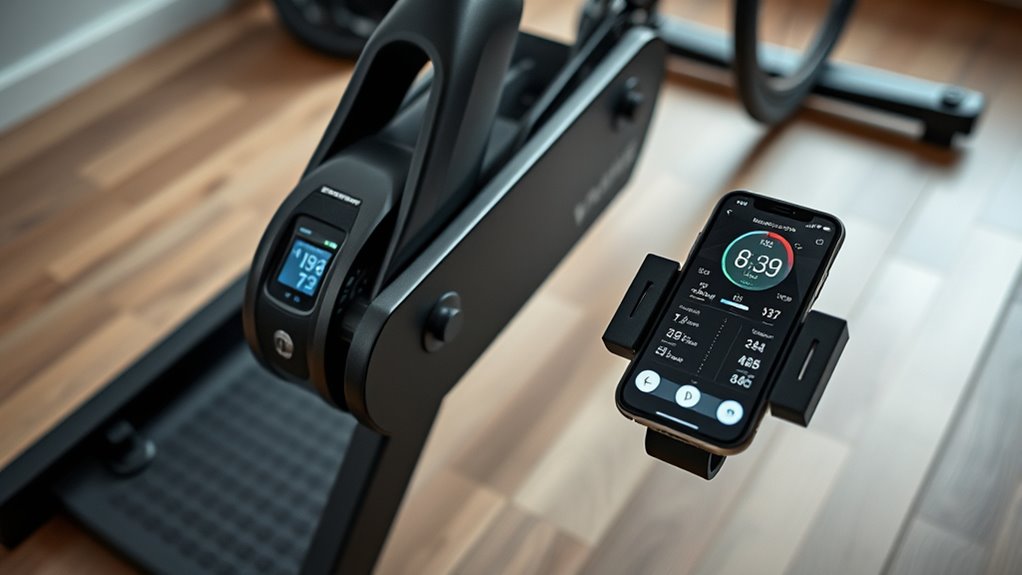
To get the most accurate readings and smooth control, start by properly connecting your smart trainer and power meters via Bluetooth or ANT+. Make sure to activate ERG mode on your trainer’s interface for automatic resistance adjustments. Don’t forget to calibrate your equipment before each session to guarantee precision and reliable data. Additionally, consider sensor synchronization to ensure all devices work seamlessly together, which can enhance your training experience. Additionally, consider special occasions such as birthdays or anniversaries to celebrate milestones and keep motivation high throughout your training journey. To further improve accuracy, pay attention to color temperature adjustments, which can influence how your data is displayed and interpreted during your workout. As the use of advanced automation and data management grows, understanding data privacy challenges becomes increasingly important to protect your personal workout information.
Connect Smart Trainer Properly
Connecting your smart trainer correctly is essential for reliable control and accurate power readings. To do this, guarantee your trainer’s control and power icons are visible when connected via Bluetooth or ANT+. Confirm that the trainer is compatible with control features and that the firmware is up to date. When using ERG mode, connect both control and power icons; for Power Meter display, disconnect ERG control and switch to power mode. A proper setup involves verifying a stable connection, so resistance adjustments respond smoothly. Use the trainer’s official guides for connection details. Regularly check your connection icons, firmware updates, and signal strength. This ensures your trainer provides precise power data, making your training effective and consistent. Ensuring proper device compatibility is crucial for optimal performance and accurate readings.
Calibrate for Precision
Calibrating your smart trainer is a crucial step to guarantee accurate power readings and consistent resistance levels. Proper calibration involves performing a spin-down or roll-down test to measure rolling resistance and establish a precise power baseline. It’s best to calibrate after 15-20 minutes of riding, as heat buildup from tire contact and resistance units can skew power data. Following the manufacturer’s calibration procedures—such as warming up, then zeroing or spin-down—is essential for maintaining reliable power measurement over time. Regular calibration, especially after changes in tire pressure or temperature, helps reduce drift during workouts and ensures resistance levels match your efforts accurately. This process guarantees your smart trainer delivers precise power data, making your indoor training more effective and trustworthy. Additionally, understanding essential oils for respiratory health can help support overall well-being during intense training sessions. Maintaining proper calibration frequency ensures consistent performance and accurate feedback throughout your training regimen.
Connecting and Calibrating External Power Meters With Your Devices
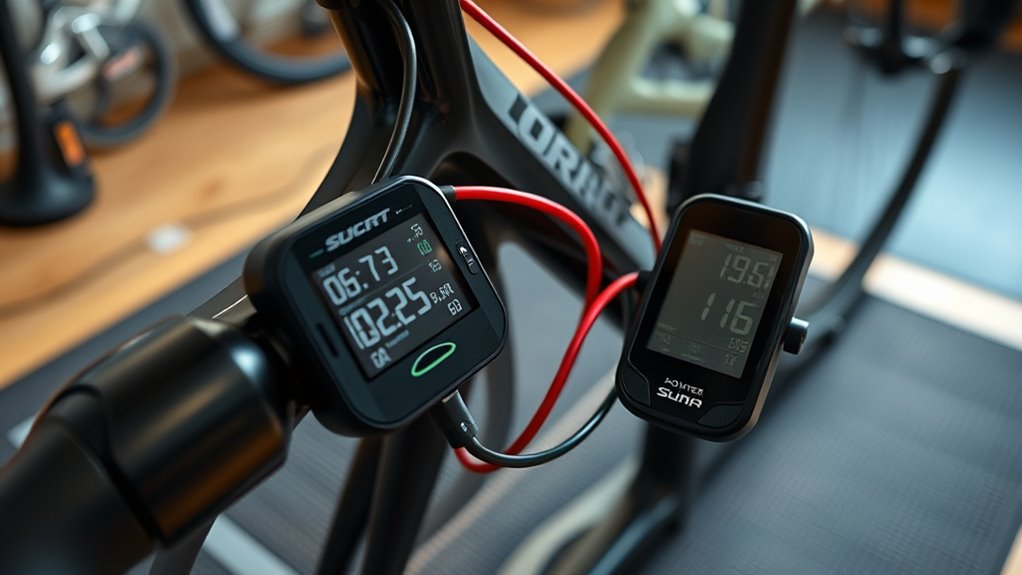
Ensuring your external power meter works seamlessly with your device involves a few straightforward steps. First, connect your power meter directly via Bluetooth or ANT+—this guarantees accurate data transmission. Next, use your device’s pairing menu to select your preferred smart power meter sensor, avoiding conflicts from multiple sources. Regular calibration is essential; follow the manufacturer’s instructions, especially before intense workouts, to keep readings precise. Keep your power meter’s firmware and device software up to date to prevent compatibility issues. Remember, some power meters may report different wattages due to drivetrain losses or L/R imbalances—be aware of this when calibrating. Additionally, understanding the growing and harvesting chia seeds process can help you optimize your gardening setup and ensure healthy plant growth. Properly managing sensor compatibility is crucial for consistent performance and accurate data collection. Implementing a risk assessment can help identify potential issues before they affect your training data. Finally, consult specific setup guides for your device and power meter model to optimize your connection and calibration process.
Using Power Match to Harmonize Data From Multiple Power Sources
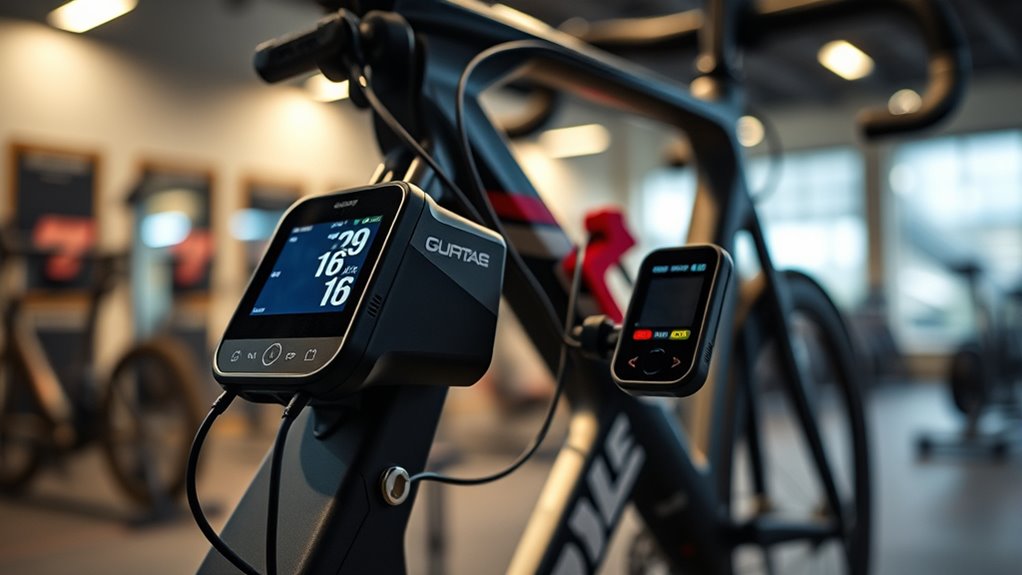
Using Power Match can markedly improve the accuracy and consistency of your indoor training by syncing data from your external power meter with your smart trainer. When enabled, Power Match overrides your trainer’s internal power readings with those from your power meters, providing a single, reliable power figure for training and analysis. This feature helps eliminate discrepancies between devices, ensuring your efforts are accurately captured regardless of the power source. Compatibility varies by software, with Zwift and TrainerRoad supporting Power Match, while Garmin Edge devices typically do not. Before using Power Match, it’s crucial to calibrate both your trainer and power meters to minimize errors. Proper calibration and consistent maintenance are essential for optimal performance. Regularly checking and calibrating your devices can further enhance measurement accuracy. This process can be especially beneficial when working to improve trust issues with devices, ensuring your data remains reliable during all training sessions. Additionally, understanding the potential nutrient deficiencies in your training diet can support overall performance and recovery. Incorporating device calibration protocols can also help maintain measurement precision over time, further enhancing your training data reliability. Overall, Power Match helps maintain consistent power data during transitions between outdoor and indoor workouts, giving you confidence in your training metrics.
Managing Power Data for Indoor and Outdoor Training Consistency
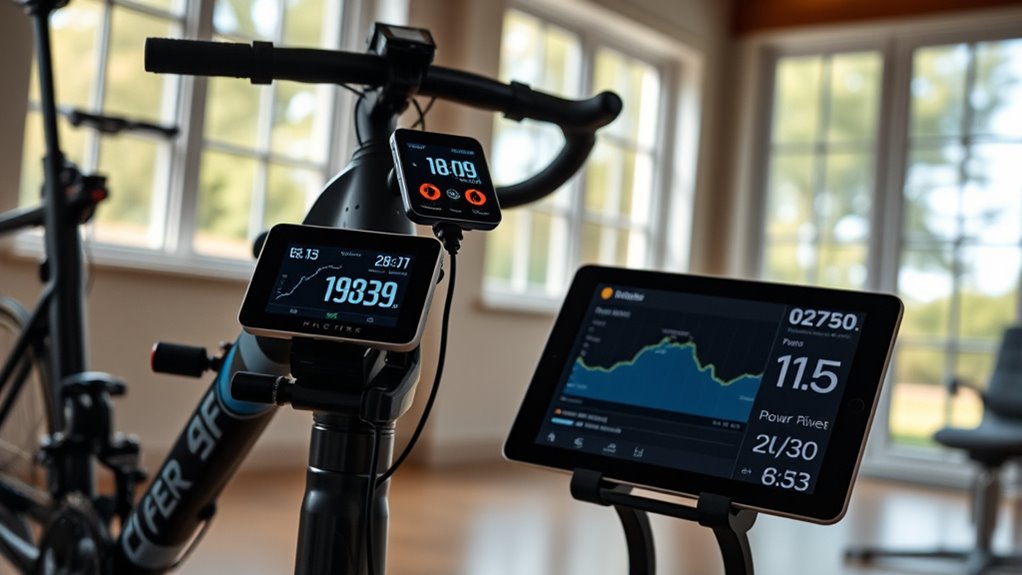
Maintaining consistent power data across indoor and outdoor workouts starts with using the same reliable power meter. This ensures a single, calibrated source of measurement, reducing discrepancies. When you use a power meter with your smart trainer, you get accurate data regardless of environment. Features like Power Match in Zwift or TrainerRoad let you overwrite your trainer’s power with your external meter for greater precision indoors. Regular calibration of both your smart trainer and power meter is essential to keep data aligned. By matching your external power readings with your trainer’s, you can confidently track progress and compare efforts. Proper calibration and understanding of Resources and Training are vital for maintaining data accuracy. Visualize your training with:
- Clear, consistent power readings during every ride
- Reduced data discrepancies between outdoor and indoor sessions
- Accurate effort measurement regardless of terrain
- Reliable progress tracking over time
- Better training decisions based on precise data
Troubleshooting Power Discrepancies and Ensuring Data Accuracy
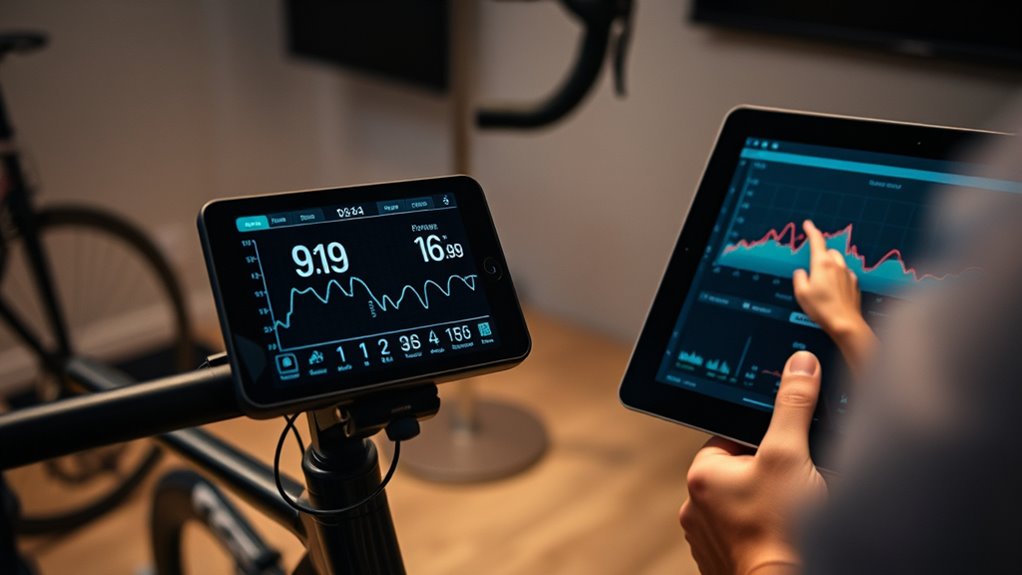
Power discrepancies between smart trainers and power meters are common, but understanding their causes can help you troubleshoot effectively. Variations often stem from drivetrain losses, calibration differences, and measurement methods, affecting the accuracy of your power data. To improve accuracy, regularly calibrate both your trainer and power meter, and keep your devices consistent in use. Features like PowerMatch in compatible software can help synchronize power readings during indoor sessions. External factors such as temperature, tire pressure, and L/R imbalances also influence power measurements, causing fluctuations. Monitoring these variances allows you to identify potential issues and make informed adjustments. By paying attention to these factors, you ensure your power data remains as accurate as possible, helping you train smarter and track your progress more reliably.
Leveraging Power Data to Enhance Training and Performance
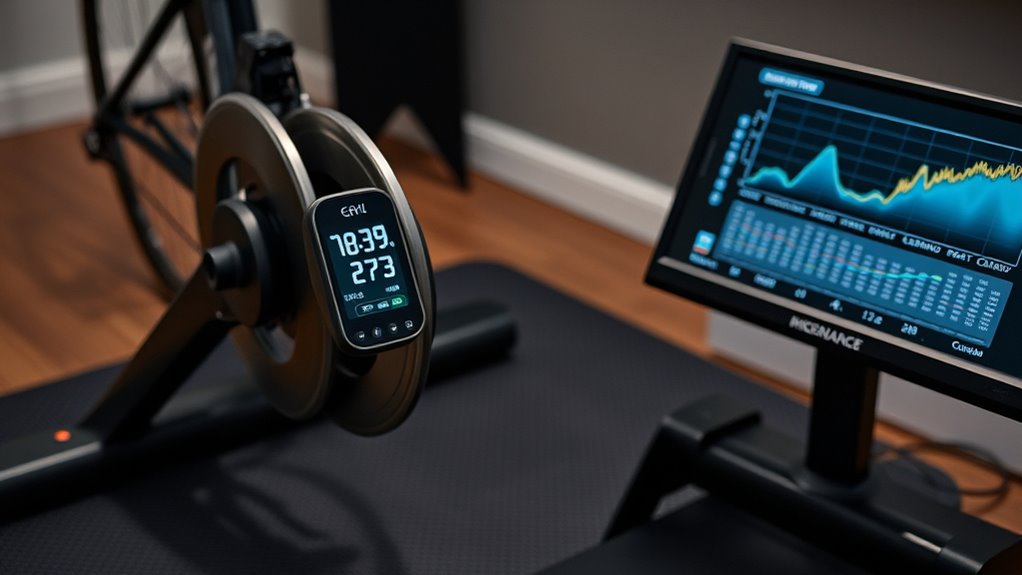
Accurate power data isn’t just about numbers; it’s a key tool for tailoring your training and pushing your performance forward. When you leverage precise power data, you can fine-tune your workouts, set realistic goals, and monitor progress with confidence. With integrated systems like PowerMatch, resistance adjusts based on your actual power output, simulating outdoor efforts indoors. Regular calibration of your power meter and smart trainer guarantees data accuracy, allowing better pacing and FTP assessments. Pairing a power meter directly to your trainer minimizes discrepancies between outdoor and indoor readings. This detailed insight helps you:
- Visualize your effort levels during intervals
- Identify strength and weakness areas
- Optimize training zones
- Track improvements over time
- Make informed decisions for peak performance
Exploring Compatibility and Future Enhancements in Power Integration
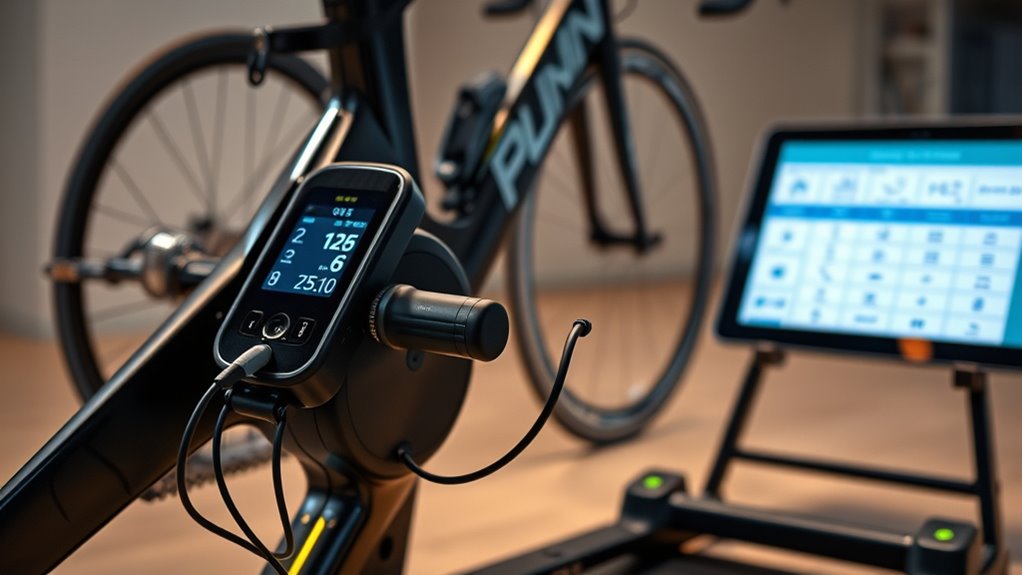
As technology advances, compatibility between power meters and smart trainers is becoming more essential for a seamless indoor cycling experience. Many smart trainers now support direct connection to power meters via ANT+ or Bluetooth, improving data accuracy. Features like PowerMatch enable the trainer to control resistance based on external power data, enhancing training precision. Future updates from manufacturers like Garmin are expected to further improve power integration, allowing smoother use of multiple power sources. Directly pairing a power meter with a smart trainer can minimize discrepancies between outdoor and indoor data, ensuring consistent training. Ongoing developments aim to introduce multi-source blending and automatic calibration, optimizing power data management. These enhancements will make your indoor workouts more accurate, reliable, and aligned with outdoor performance metrics.
Best Practices for Maintaining and Updating Your Power and Trainer Equipment
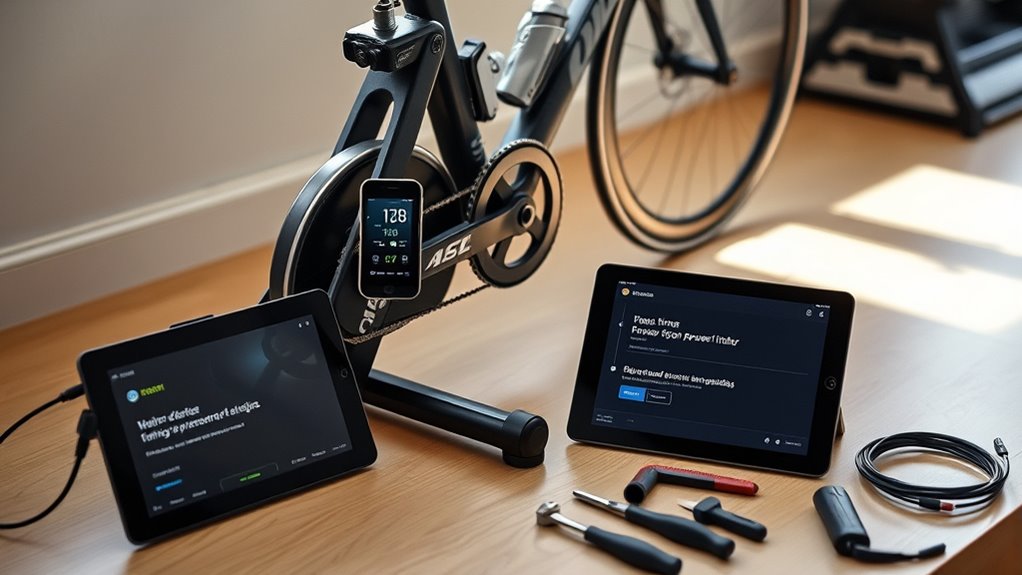
To keep your power meters and trainers accurate, you need to stay on top of regular calibration and updates. Make a habit of calibrating before each ride and installing firmware or software updates promptly. Proper maintenance guarantees your equipment remains reliable and performs at its best.
Regular Calibration Procedures
Regular calibration is essential for keeping your smart trainer and power meter providing reliable data. By performing routine calibration, you ensure accurate power readings and consistent performance. After 15-20 minutes of riding, do a spin-down or roll-down calibration to account for heat buildup and tire pressure changes. Calibrate whenever you notice power readings drifting or becoming inconsistent. Always warm up your trainer before calibration to reach ideal temperature, as resistance units generate heat that affects measurements. Use manufacturer-recommended methods and tools, like Elite’s spin-down or Power2Max’s auto-calibration, for best results. Remember to recalibrate periodically, especially after firmware updates or environmental changes, to maintain precise data.
- Visualize the trainer warming up before calibration
- Imagine adjusting resistance to match expected power
- Think of using specific tools for calibration
- Picture the trainer cooling down after calibration
- Envision consistent power data during rides
Firmware and Software Updates
Keeping your firmware and software up to date guarantees your power meter and smart trainer perform reliably with the latest features and fixes. Regularly check for firmware updates from the manufacturer to ensure best operation and bug fixes. Always install software updates through official apps or platforms, following the provided instructions to prevent compatibility issues or data loss. Keep your devices connected to stable power sources during updates to avoid interruptions that could corrupt firmware or software. Review release notes beforehand to understand new features, improvements, and any calibration or setup changes needed. Additionally, back up your device settings and calibration data before updating, so you can quickly recover if any issues arise during the process. Staying current maximizes device performance and longevity.
Frequently Asked Questions
How Do I Connect My Power Meter to Kickr?
To connect your power meter to the Kickr, first pair it via Bluetooth or ANT+ on your cycling computer or training app. Make certain the power meter is recognized and active. Calibrate it as per the manufacturer’s instructions for accuracy. Then, select your power meter as the primary power source in your app or device settings. Enable powermatch if needed to ensure precise power readings during your workout.
How to Pair Power Meter With Zwift?
You might think pairing your power meter with Zwift is complex, but it’s straightforward. First, confirm your device supports Bluetooth or ANT+ and is within range. Open Zwift, go to the pairing screen, and select your power meter. Turn it on with recent firmware. Make it your primary power source, then verify Zwift displays accurate data. If successful, you’re all set to ride with precise power readings.
Can You Put a Power Meter on a Stationary Bike?
Yes, you can put a power meter on a stationary bike. You’ll want to choose a compatible type, like pedal-based or crank-based meters, and guarantee your bike has the right mounting points. Make sure the power meter is compatible with your cycling computer or training app for accurate data. Check your bike’s specifications first, as not all stationary bikes support third-party power meters.
Why Is My Power Meter Output Different From My Smart Trainer?
You notice your power meter output differs from your smart trainer because they measure power differently. Power meters often measure force upstream, which can be 1-2% higher due to drivetrain losses. Variations in calibration, sensor technology, and external factors like tire pressure or temperature also affect readings. Consistently calibrate both devices and use the same power source to get more accurate, comparable data.
Conclusion
As you pedal through your training sessions, imagine your power meter and smart trainer working in seamless harmony, like a well-conducted orchestra. With precise calibration and thoughtful integration, you’ll release detailed insights that push your performance higher. Keep your equipment updated and troubleshoot wisely, so your indoor rides mirror outdoor adventures perfectly. Embrace these tools, and watch your progress accelerate, turning every workout into a confident stride toward your peak potential.
